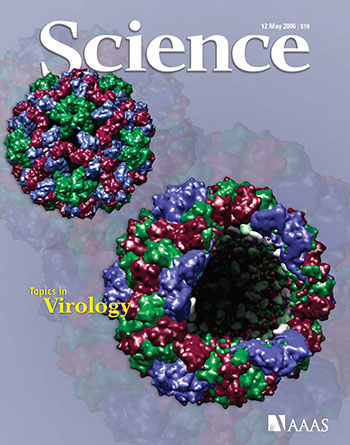Outreach Highlights
TBI Scientists Douglas and Young Turn Old Foes into New Friends
Viruses have a bad reputation. The virus, whose essential nature is to infect a host
cell, replicate and package its nucleic acid, and move on, has long been viewed as
nothing more than a carrier of disease. However, two TBI scientists are taking a second
look at viruses and discovering amazing potential.
Viruses may be the most abundant biological entity on the plant, second only to prokaryotes
in biomass. They come in an amazing array of shapes and sizes, from 18 to 500 nm for
icosahedral structures to >2 μm for rod-shaped viruses. Viruses have also evolved
to move through a wide range of chemical environments, and they exhibit remarkable
plasticity; they can be chemically and genetically altered without affecting their
overall architecture or stability. For example, it is possible to reverse the charge
on the interior surface of the capsid from positive to negative without changing the
structure of the virus, or its ability to assemble.
Sometimes, either spontaneously or through genetic manipulation, a virus will assemble
an empty, noninfectious container, which does not contain genetic material. For Douglas
and Young, these empty viruses have the potential to become the perfect carrying case
for nanoscale materials. Medically therapeutic chemicals, such as the anticancer drug
doxorubicin, can be “caged” in a virus until directed to release the chemicals at
the targeted cell.
Viruses interact with their environment through their exterior surface, a perfect
platform for multivalent presentation. This multivalent surface allows the virus to
target specific cell and tissue types, and to avoid the host’s defense mechanisms,
properties with clear implications for drug delivery. The virus cages that Douglas
and Young are researching could act like tiny Trojan horses, carrying therapeutic
drugs directly to the cells that need them while minimizing unintended damage to healthy
cells.
The biological world is often viewed as a limited source of raw materials, because
most organisms exist in such a narrow range of temperature and chemical conditions.
Douglas and Young, along with other TBI scientists, are challenging this perception
through their discovery of life and its associated viruses in Yellowstone National
Park’s extreme thermal environments. Viruses that are able to survive in areas previously
believed to be completely devoid of life have received their reputation unfairly—future
virus applications may help to cure disease, not cause it.
Science 12 May 2006: Vol. 312. no. 5775, pp. 873 - 875

These findings were featured on the cover of the May 2006 issue of Science Magazine
